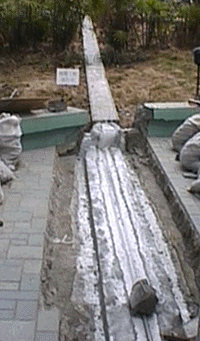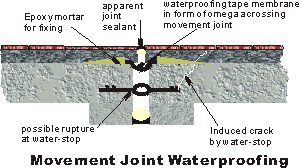![]()
Movement Joint Repairing
There are various types of joints commonly encountered in reinforced
concrete construction. They are :-
In any construction it is necessary to ensure that such joints are watertight with various types of joint sealant available. However, those joints even with high standard of performance may be likely deteriorated by the variations of loading, temperature and structural movement in a long run.
Here is a typical diagram showing the repairs to the movement joint in which the water-stop is positioned during concreting in the construction stage. Hairline cracks may be induced along the joint by shear force and must be repaired by epoxy injection to achieve the strength of the structural concrete. The joint membrane should be positioned as close to the water-stop as possible to accomplish original design. To allow movement as its name implies, special cares is taken to ensure the membrane is flexible to move across the joints and firmly fixed to structural concrete. In case the joint is situated in basement, stopping or diverting leaking water should be done first to provide a dry surface of the structural concrete prior to the installation of the waterproofing system to the joint.
 Depending on the construction, failure of water leaking in the joint
may not be wholly the problem of the joint sealant itself. If there is any construction
joint in the movement joint, it will be one of the weakest point contributing to the water
leaking, particularly the sliding joint which is sometimes hidden from the exposed one.
Anyway, the movement joint is the most vulnerable to the entry of water and therefore it
is recommended to install a tail-made drip tray underneath for precaution.
Depending on the construction, failure of water leaking in the joint
may not be wholly the problem of the joint sealant itself. If there is any construction
joint in the movement joint, it will be one of the weakest point contributing to the water
leaking, particularly the sliding joint which is sometimes hidden from the exposed one.
Anyway, the movement joint is the most vulnerable to the entry of water and therefore it
is recommended to install a tail-made drip tray underneath for precaution.
¡@